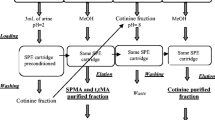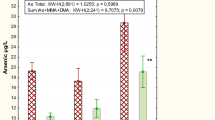Abstract
This article reports the results of a study, conducted in the framework of the scientific activities of the Italian Society for Reference Values, aimed at defining reference values of urinary trans,trans-muconic acid (t,t-MA) in the general population not occupationally exposed to benzene. t,t-MA concentrations detected in 376 subjects of the resident population in three areas of Italy, two in central (Florence and southern Tuscany) and one in northern Italy (Padua), by three laboratories, compared by repeated interlaboratory controls, showed an interval of 14.4–225.0 μg/L (5th–95th percentile) and a geometric mean of 52.5 μg/L. The concentrations measured were influenced by tobacco smoking in a statistically significant way: Geometric mean concentrations were 44.8 μg/L and 76.1 μg/Ll in nonsmokers (264 subjects) and smokers (112 subjects), respectively. In the nonsmoking population, a significant influence of gender was found when concentrations were corrected for urinary creatinine, geometric mean concentrations being 36.7 μg/g creatinine in males (128 subjects) and 44.7 μg/g creatinine in females (136 subjects). The place of residence of subjects did not seem to influence urinary excretion of the metabolite, although personal inhalation exposure to benzene over a 24-h period showed slightly higher concentrations in Padua and Florence (geometric means of 6.5 μg/m3 and 6.6 μg/m3, respectively) than in southern Tuscany (geometric mean of 3.9 μg/m3). Concentration of t,t-MA in urine samples collected at the end of personal air sampling showed little relationship to personal inhalation exposure to benzene, confirming the importance of other factors in determining excretion of t,t-MA when concentrations in personal air samples are very low.

Similar content being viewed by others
References
Adami G, Larese F, Venier M, Barbieri P, Lo Coco F, Reisenhofer E. (2006) Penetration of benzene, toluene and xylenes contained in gasolines through human abdominal skin in vitro Toxicol in Vitro 20:1321–1330
Adikofer F, Scherer G, Conze C, Angerer J, Lehnert G (1990) Significance of exposure to benzene and other toxic compounds through environmental tabacco smoke. J Cancer Res Clin Oncol 116:591–598
Bergamaschi E, Brustolin A, De Palma G, et al. (1999) Biomarkers of dose and susceptibility in cyclists exposed to monoaromatic hydrocarbons. Toxicol Lett 108:241–247
Bini G, Di Vaio V, Liguori E, Marini E, Pagliai L (1998) Carcinogens in the urban environment of Italian cities: benzene and benzo(a)pyrenes. Med Lav 89:177–187
Boogaard PJ, van Sittert NJ (1996) Suitability of S-phenyl mercapturic acid and trans-trans-muconic acid as biomarker for exposure to low concentrations of benzene. Environ Health Perspect 104(Suppl 6):1151–1157
Cao XL, Casey V, Seaman S, Tague B, Becalski A (2007) Determination of benzene in soft drinks and other beverages by isotope dilution headspace gas chromatography/mass spectrometry. J AOAC Int 90:479–484
Carrer P, Maroni M, Alcini D, et al. (2000) Assessment through environmental and biological measurements of total daily exposure to volatile organic compounds of office workers in Milan. Indoor Air 10:258–268
Chan CC, Spengler JD, Ozkaynak H, Lefkopoulou M (1991) Commuter exposure to VOCs in Boston, Massachusetts. J Air Waste Manag Assoc 41:1594–1600
Cocco P, Tocco MG, Ibba A, et al. (2003) Trans, trans-muconic acid excretion in relation to environmental exposure to benzene. Int Arch Occup Environ Health 76:456–460
Cocheo V, Sacco P, Boaretto C, et al. (2000) Urban benzene and population exposure. Nature 404:141–142
Crebelli R, Tomei F, Zijno A, et al. (2001) Exposure to benzene in urban workers: environmental and biological monitoring of traffic police in Rome. Occup Environ Med 58:165–171
Ducos P, Gaudin R, Bel J, et al. (1992) Trans,trans-muconic acid, a reliable biological indicator for the detection of individual benzene exposure down to ppm level. Int Arch Occup Environ Health 64:309–313
Fustinoni S, Buratti M, Campo L, et al. (2005) Urinary t,t-muconic acid, S-phenylmercapturic acid and benzene as biomarkers of low benzene exposure. Chem Biol Interact 153–154:253–256
Gilli G, Scursatone E, Bono R (1994) Benzene, toluene and xylenes in air, geographical distribution in the Piedmont region (Italy) and personal exposure. Sci Total Environ 148:49–56
Gobba AM, Rovesti S, Borella P, Vivoli R, Caselgrandi E, Vivoli G (1997) Inter-individual variability of benzene metabolism to trans,trans-muconic acid and its implications in the biological monitoring of occupational exposure. Sci Total Environ 199:41–48
Hill RH Jr, Head SL, Baker S, et al. (1995) Pesticide residues in urine of adults living in the United States: reference range concentrations. Environ Res 71:99–108
Imbriani M, Fiorentino ML, Maestri L, Marsilio MG, Ghittori S (1996) Indoor pollution and biological monitoring of volatile organic compounds (VOC). G Ital Med Lav 18:151–160
Johnson ES, Langard S, Lin YS (2007) A critique of benzene exposure in the general population. Sci Total Environ 374:183–198
Kim MY, Harrad S, Harrison RM (2001) Concentrations and sources of VOCs in urban domestic and public microenvironments. Environ Sci Technol 35:997–1004
Kim S, Vermeulen R, Waidyanatha S, et al. (2006) Using urinary biomarkers to elucidate dose-related patterns of human benzene metabolism. Carcinogenesis 27:772–781
Lagorio S, Crebelli R, Ricciarello R, et al. (1998) Methodological issues in biological monitoring of low level exposure to benzene. Occup Med 48:497–504
Lee BL, Ong HY, Ong YB, Ong CM (2005) A sensitive liquid chromatographic method for the spectrometric determination of urinary trans,trans-muconic acid. J Chromatogr B 818:277–283
Lee JW, Jo WK (2002) Actual commuter exposure to methyl-tertiary butyl ether, benzene and toluene while traveling in Korean urban areas. Sci Total Environ 291:219–228
Lin LC, Chiung YM, Shih JF, Shih TS, Liao PC (2006) Validation of an online-dual loop cleanup device with an electrospray ionisation tandem mass-spectrometry-based system for simultaneous quantitative analysis of urinary benzene exposure biomarkers trans, trans-muconic acid and S-phenylmercapturic acid. Anal Chim Acta 555:34–40
Lin LC, Shih JF, Shih TS, Li YJ, Liao PC (2004) An electrospray ionization tandem mass spectrometry based system with an online dual-loop cleanup device for simultaneous quantitation of urinary benzene exposure biomarkers trans,trans-muconic acid and S-phenylmercapturic acid. Rapid Commun Mass Spectrom 18:2743–2752
Manini P, Andreoli R, Mutti A (2006a) Application of liquid chromatography–mass spectrometry to biomonitoring of exposure to industrial chemicals. Toxicol Lett 162:202–210
Manini P, De Palma G, Andreoli R, et al. (2006b) Environmental and biological monitoring of benzene exposure in a cohort of Italian taxi drivers. Toxicol Lett 167:142–151
Marrubini G, Coccini T, Maestri L, Manzo L (2002) Effect of sorbic acid administration on urinary trans,trans-muconic acid excretion in rats exposed to low levels of benzene. Food Chem Toxicol 40:1799–1806
Marrubini G, Coccini T, Manzo L (2001) Direct analysis of urinary trans,trans-muconic acid by coupled column liquid chromatography and spectrophotometric ultraviolet detection: method applicability to human urine. J Chromatogr B Biomed Sci Appl 758:295–303
Melikian AA, Qu Q, Shore R, et al. (2002) Personal exposure to different levels of benzene and its relationships to the urinary metabolites S-phenylmercapturic acid and trans,trans-muconic acid. J Chromatogr B: Analyt Technol Biomed Life Sci 778:211–221
Minoia C, Apostoli P (1999) Activity of the Italian Society of Reference Values. Int Arch Occup Environ Health 72:268–270
Minoia C, Apostoli P (2003) First SIVR list of reference values: definitions, methodologic criteria and analytical strategies. G Ital Med Lav Erg 25:15–21
Moriguchi J, Ezaki T, Tsukahara T, et al. (2005) Decreases in urine specific gravity and urinary creatinine in elderly women. Int Arch Occup Environ Health 78:438–445
Nakai JS, Chu I, Li-Muller A, Aucoin R (1997) Effect of environmental conditions on the penetration of benzene through human skin. J Toxicol Environ Health 51:447–462
Negri S, Bono R, Maestri L, Ghittori S, Imbriani M (2005) High-pressure liquid chromatographic-mass spectrometric determination of sorbic acid in urine: verification of formation of trans,trans-muconic acid. Chem Biol Interact 153–154:243–246
Olmos V, Lenzken SC, Lopez CM, Villaamil EC (2006) High-performance liquid chromatography method for urinary trans,trans-muconic acid. Application to environmental exposure to benzene. J Anal Toxicol 30:258–261
Ong CN (1999) Reference values and action levels of biological monitoring in occupational exposure. Toxicol Lett 108:127–135
Park JH, Spengler JD, Yoon DW, Dumyahn T, Lee K, Ozkaynak H (1998) Measurement of air exchange rate of stationary vehicles and estimation of in-vehicle exposure. J Exp Anal Environ Epidemiol 8:65–78
Pavanello S, Simioli P, Carrieri M, Gregorio P, Clonfero E (2002) Tobacco-smoke exposure indicators and urinary mutagenicity. Mutat Res 521:1–9
Pezzagno G, Maestri L, Fiorentino ML (1999) Trans,trans-muconic acid, a biological indicator to low levels of environmental benzene: some aspects of its specificity. Am J Ind Med 35:511–518
Qu Q, Melikian AA, Li G, et al. (2000) Validation of biomarkers in humans exposed to benzene: urine metabolites. Am J Ind Med 37:522–531
Qu Q, Shore R, Li G, et al. (2005) Biomarkers of benzene: urinary metabolites in relation to individual genotype and personal exposure. Chem Biol Interact 153–154:85–95
Renner T, Baer-Koetzle M, Scherer G (1999) Determination of sorbic acid in urine by gas-chromatography-mass spectrometry. J Chromatogr A 847:127–133
Rossi AM, Guarnieri C, Rovesti C, et al. (1999) Genetic polymorphisms influence variability in benzene metabolism in humans. Pharmacogenetics 9:445–451
Ruppert T, Scherer G, Tricker AR, Adlkofer F (1997) Trans,trans-muconic acid as a biomarker of non-occupational environmental exposure to benzene. Int Arch Occup environ Health 69:247–251
Saieva C, Tumino R, Masala G, et al. (2003) Urinary 1-hydroxypyrene and t,t-muconic acid as biomarkers of exposure to environmental pollutants in two areas in Italy (EPIC-Florence and Ragusa). Tumori 89:679–686
Schneider P, Lorinci G, Gebefugi L, Heinrich J, Kettrup A, Wichmann HE (1999) Vertical and horizontal variability of volatile organic compounds in homes in Eastern Germany. J Exp Anal Environ Epidemiol 9:282–292
Shahtaheri SJ, Ghamari F, Golbabaei F (2005) Sample preparation followed by high performance liquid chromatographic (HPLC) analysis for monitoring muconic acid as a biomarker of occupational exposure to benzene. Int J Occup Safety Ergon 11:377–388
Sinclair GC, Wester RC, Maibach HI (2002) Partition coefficients for benzene in human skin. AIHA J (Fairfax, Va) 63:685–688
Snyder R, Hedli CC (1996) An overview of benzene metabolism. Environ Health Perspect 104(Suppl 6):1165–1171
Thrall KD, Gies RA, Muniz J, Woodstock AD, Higgins G (2002) Route-of-entry and brain tissue partition coefficients for common superfund contaminants. J Toxicol Environ Health A 65:2075–2086
Verdina A, Galati R, Falasco G, et al. (2001) Metabolic polymorphisms and urinary biomarkers in subjects with low benzene exposure. J Toxicol Environ Health 64:607–618
Wallace L (1996) Environmental exposure to benzene: an update. Environ Health Perspect 104(Suppl 6):1129–1136
Weaver VM, Buckley T, Groopman JD (2000) Lack of specificity of trans,trans-muconic acid as a benzene biomarker after ingestion of sorbic acid-preserved foods. Cancer Epidemiol Biomarker Prevent 9:749–755
Wester RC, Maibach HI (2000) Benzene percutaneous absorption: dermal exposure relative to other benzene sources. Int J Occup Environ Health 6:122–126
Acknowledgment
The article was reviewed and approved by the Directive Board of the Italian Society for Reference Values (SIVR): P. Apostoli, M. Bettinelli, C. Aprea, I. Pavan, L. Perbellini, A. Perico, M.C. Ricossa, A. Ronchi, M.L. Scapellato, and S. Spezia.
Author information
Authors and Affiliations
Corresponding author
Rights and permissions
About this article
Cite this article
Aprea, C., Sciarra, G., Bozzi, N. et al. Reference Values of Urinary Trans,trans-muconic Acid: Italian Multicentric Study. Arch Environ Contam Toxicol 55, 329–340 (2008). https://doi.org/10.1007/s00244-007-9119-9
Received:
Accepted:
Published:
Issue Date:
DOI: https://doi.org/10.1007/s00244-007-9119-9




